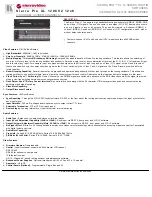
5
Fault Isolation
A fault is a condition that impedes the flow of traffic across the network. Fault isolation, as its
name implies, is the ability to locate the source of a failure and isolate it before it impacts
network communications.
Managed switches that support fault isolation can identify potential and actual problems caused
by various factors, such as traffic patterns, traffic congestion, and port status.
Capacity Planning
Change is the one constant in small-business networking environments, where new applications
and new users are continually being added. Despite the dynamic nature of their networks, most
small businesses lack the in-house expertise to determine what resources will be required to
provide adequate network stability and performance, at a reasonable price, 45, 30, even 15 days
from today. Worse, most small businesses can't budget against a guess.
For this reason, some managed switches support capacity planning. These features allow small
businesses to obtain a good reading of their current networking requirements so they can
ascertain the viability of future solutions.
The objective of capacity planning is to analyze current workloads and reserve capacity, and
provide estimates of workload growth and sizing of new applications. Based on that
information, estimates of the resources required to support future workloads can be estimated.
With capacity planning, small businesses can:
Measure their current network capacity
For example, determine which switch ports handle the most network traffic and which
handle the least
and at which times.
Understand how changes affect their network
For example, how adding users and applications affect the network. In some cases, small
businesses may need to add more network capacity or upgrade their hardware (such as
moving from Ethernet or Fast Ethernet to Gigabit Ethernet) to handle these changes. In
other cases, they might be able to accommodate the changes within the current network.
Identify network capacity changes
As more users and resources are added to the network, small businesses can identify
changes and trends in network capacity and utilization patterns and identify network
service-improvement opportunities.
Plan for growth based on future resource requirements
As you become more familiar with your network capacity and the factors that affect
growth, and learn how to recognize changes and trends, you can proactively plan for
network growth.
In this way, capacity planning allows small businesses to determine where and when to add new
capacity, stay ahead of their networking needs, justify purchases more easily, and deploy existing
solutions more efficiently.
































